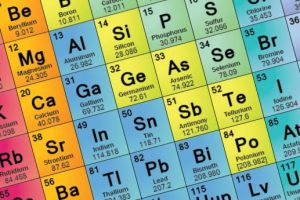These are elements that are vital to plant growth but are only required in minute amounts, very much like vitamins in human diets. They are known as micro-nutrients because of the tiny amounts found in normal soils.
 For the average home vegetable grower micro nutrients are an academic rather than a practical subject. Identifying micro nutrient deficiencies is difficult even for experts and usually requires laboratory analysis. With iron deficiency, even laboratory analysis is difficult.
For the average home vegetable grower micro nutrients are an academic rather than a practical subject. Identifying micro nutrient deficiencies is difficult even for experts and usually requires laboratory analysis. With iron deficiency, even laboratory analysis is difficult.
Luckily for us, most of these deficiencies are very rare and rotation, use of compost and manures will cure them.
Boron (B)
Boron is necessary for calcium to perform its functions in the plant but too much boron is also harmful to the plant. Excess use of magnesium sulphate will also cause a boron imbalance. The symptoms of boron deficiency are poor development of the growing tip of the plant. It is more likely in soils with pH above 6.5.
Confirming boron deficiency is a job for laboratory analysis but some indicators are:
- Broccoli – Hollow stems, internal discoloration, brown curds.
- Cabbage – Hollow stem, watery areas, heads hollow, plants stunted.
- Carrots – Reddening of leaves and root splitting.
- Cauliflower – Leaves curled, hollow stem, curds dwarfed, brown.
- Celery – Stem cracked and striped brown, heart blackened.
- Lettuce – Stunted growth, discolouration of leaves, brittle.
- Radish – Pale roots, brittle stems, watery flesh and flecked colouration
- Swede – Roots are tough, fibrous and bitter. Upon cutting, they have soft, watery areas, often called “brown-heart.”
- Sweet Corn – Short, bent cobs, barren ears, blank stalks, poor kernel development, elongated, watery or transparent stripes later becoming white on newly formed leaves, dead growing points.
- Tomatoes – Thickened leaves, brittle leaves, fruit fails to set.
- Turnips – Hollow centre or brown heart, watery areas.
Adding borax to the soil will correct the deficiency but borax is also a herbicide. For garden growers who are unlikely to want to pay for professional testing and recommendations the best advice is to avoid over use of magnesium sulphate, rotate and use plenty of home made compost.
Copper (Cu)
Copper deficiency is rare but can occur on sandy, peaty and chalky soils with their high pH levels. It is required for root formation. Once again it requires professional analysis to confirm and to determine a proper course of action to rectify. Usually the single use of a copper sulphate based fungicide (Bordeaux mixture) will re-stock the soil for as long as you are likely to grow on it.
Excess copper is very toxic to plants and to people. In plants it causes reduced growth, yellowing of the foliage, and stunted root development
Iron (Fe)
Iron is needed for chlorophyll production, which is what the green colour in leaves is. Iron deficiency causes yellowing of the leaves and a general lack of vigour. It is fortunately rare but unfortunately hard to both diagnose or determine by laboratory analysis.
Generally not something the home grower needs to concern himself with but should you suspect you have it then use sulphate of iron fertilizer on a test patch.
Do keep in mind that too much iron is more of a problem as it locks up the potassium and phosphorus in the soil making it unavailable to the plants.
Manganese (Mn)
Manganese deficiency is often caused by over liming and is most often found on peaty and sandy soils with a high pH. Symptoms are similar to iron deficiency and can be confirmed by laboratory analysis of the leaf. Susceptible crops include peas and beets.
Adding sulphur to the soil, which will increase the acidity (decreasing pH) will solve the problem.
The following micro-nutrients are rarely lacking and analysis and remedy are professional jobs. Normal additions of composts and manures will resolve deficiency problems. Excess in the soil will probably be due to industrial contamination.
Molybdenum (Mo)
Molybdenum is only required in minute amounts, 50 grams per hectare is sufficient for most crops. Excess molybdenum is as harmful as molybdenum deficiency.
Molybdenum’s function is to enable the fixation of nitrogen in legumes and its utilisation in other plants. Symptoms are similar to nitrogen deficiency with the addition that leaf edges may die.
Molybdenum deficiency is related to soil acidity and raising the soil pH to above 5.5 should resolve the problem
Zinc (Zn)
It is very similar to the effects of viral infections or lack of nitrogen – both of those are far more likely to be the cause of the problem.



